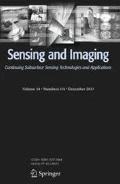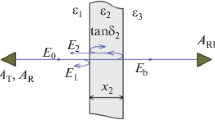Abstract
A new approach of remote sensing for buried bodies by means of reflected pulses is presented in this article. This method is based on the concept of a scattered field’s analytical continuation (Zaridze et al. in IEEE Trans Antennas Propag 50(1):50–58, 4). Soil properties were deduced using data processing and these properties analyzed. Computer simulation results of both holographic and combined holographic/photographic methods for immersed body visualizations are presented. Several ways to simplify the experimental measurements are also presented. All of these research efforts are directed towards creating a software package for high resolution image recognition devices.
































Similar content being viewed by others
References
Arthur, R., & von Hippel, E. (1954). Dielectric materials and applications. Cambridge, MA: MIT Press.
Stretton, Jn. (1949). Theory of electromagnetism. Moscow–Leningrad, p. 437.
Tabatadze, V., Prishvin, M., Saparishvili, G., Kakulia, D., Zaridze. R. (2007). Soil’s characteristics study and buried objects visualization using remote sensing. In Proceedings of 12th international seminar/workshop on direct and inverse problems of electromagnetic and acoustic wave theory (DIPED-2007), September 17–20, Tbilisi, Georgia, pp. 134–138.
Zaridze, R., Bit-Babik, G., Tavzarashvili, K., Uzunoglu, N., & Economou, D. (2002). Wave field singularity aspects large-size scatterers and inverse problems. IEEE Transactions on Antennas and Propagation, 50(1), 50–58.
Zaridze, R., Kakulia, D., Ghvedashvili, G., Saparishvili, G., Tabatadze, V., Bijamov Jr. A. (2006). Numerical simulation for experimental surface recognition based on reflected field reconstruction. In Proceedings of mediterranean microwave symposium September 19-21, 2006, Genova, Italy, pp. 204–206.
Zaridze, R., Tabatadze, V., Kakulia, D., Ghvedashvili, G., Saparishvili, G. (2006). Acceleration of total field’s reconstruction for visualization of scatterer surface. In Proceedings of the European conference on antennas & propagation (EuCAP 2006), November 6–10, Nice, France.
Zaridze, R., Kakulia, V. Tabatadze, D., Mazmanov, D., Saparishvili, G., Uzunoglou N. (2008). Development of new efficient numerical method, creation of package of program and making experimental setup for recognition of latent objects. In Proceedings of the 11th International conference on mathematical methods in electromagnetic theory (MMET–2008), Odessa, Ukraine June 29–July 02, 2008.
Author information
Authors and Affiliations
Corresponding author
Rights and permissions
About this article
Cite this article
Tabatadze, V., Kakulia, D., Saparishvili, G. et al. Development of a New Efficient Numerical Approach for Buried Object Recognition. Sens Imaging 12, 35–56 (2011). https://doi.org/10.1007/s11220-011-0060-7
Received:
Revised:
Published:
Issue Date:
DOI: https://doi.org/10.1007/s11220-011-0060-7




